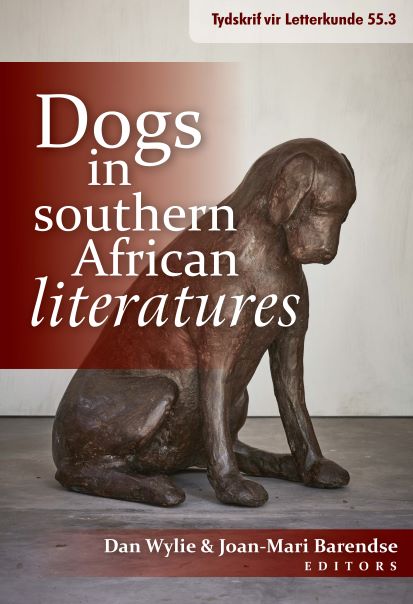Canine agents in two South African short stories
DOI :
https://doi.org/10.17159/2309-9070/tvl.v.55i3.5509Mots-clés :
dogs, gender, short fiction, textual dogsRésumé
This article explores the role of the figure of the dog in two contemporary South African short stories. It considers the metaphorical-cum-allegorical significance of the textual animal in these texts, asking how the writers use dogs as imaginative devices to draw attention to issues of gender, human emotions or psychoses, and the avowal or disavowal of (human and animal) agency. The aim is to engage with the writers’ evident wish both to comment on human-animal relationships and encounters in contemporary South African society, and to emphasise how these become effective, affective means of commenting on the continued inequities of post-apartheid society.
Téléchargements
Références
Armbruster, Karla. “Walking with Thoreau in Mind and Dogs on Leash.” Forum for World Literature Studies.
vol. 6, no. 1, 2014, pp. 68–78.
Armbruster, Karla. “‘Good Dog’: The Stories We Tell about Our Canine Companions and What They Mean for Humans
and Other Animals.” PLL: Papers on Language & Literature. Ed. Brian Abel. vol. 38, no. 4, 2002, pp.
–376.
Barris, Ken. “The Life of Worm”. The Life of Worm & Other Misconceptions. Kwela Books, 2017.
Butler, Judith. Bodies that Matter: on the Discursive Limits of “Sex”. Routledge, 1993.
Chapman, Michael. Southern African Literatures. Longman, 1999.
Cock, Jacklyn. Colonels and Cadres: War and Gender in South Africa. Oxford U P, 1991.
DePalma, Renée and Dennis Francis. “South African Life Orientation Teachers: (Not) Teaching About
Sexuality Diversity.” Journal of Homosexuality. vol. 61, no. 12, 2014, pp. 1687–1711.
“Foxy.” The Oxford English Dictionary. 3rd. ed., 2005.
Francis, Dennis. “‘You Must Be Thinking What a Lesbian Man Teacher Is Doing in a Nice Place Like Dipane
Letsie School?’: Enacting, Negotiating and Reproducing Dominant Understandings of Gender in a
Rural School in the Free State, South Africa.” Gender and Education. vol. 26, no. 5, 2014, pp. 539–
Gordimer, Nadine. “Living in the Interregnum.” The New York Review of Books. 20 January 1983.
Gqola, Pumla Dineo. “How the ‘Cult of Femininity’ and Violent Masculinities Support Endemic Gender Based
Violence in Contemporary South Africa.” African Identities. vol. 5, no. 1, 2007, pp. 111–124.
Green, Louise. “The Language of Dogs: Intermediate Forms in Global Culture.” Current Writing: Text and
Reception in Southern Africa. vol. 18, no. 1, 2006, pp. 103–118.
Halberstam, Jack. “Listen: Jack Halberstam on ‘Trans* Bodies and Power in the Age of Transgenderism’”.
Swarthmore College News & Events. 22 Dec. 2016. 5 Dec. 2017.
listen-jack-halberstam-trans-bodies-and-power-age-transgenderism>.
Haraway, Donna. The Companion Species Manifesto. Prickly Paradigm Press, 2003.
Heyns, Michiel. “‘Separate Families, Separate Worlds, the Same Native Space’: Aspects of the South African
Short Story.” Current Writing: Text and Reception in Southern Africa. vol. 17, no. 1, 2005, pp. 167–
Hines, Sally. “What’s the Difference? Bringing Particularity to Queer Studies of Transgender.” Journal of
Gender Studies. vol. 15, no. 1, 2006, pp. 49–66.
Kostelac, Sofia. “‘Imposter, Lover and Guardian’: Damon Galgut and Authorship in ‘Post-Transition’ South
Africa.” English Studies in Africa. vol. 53, no. 1, 2010, pp. 53–61.
Lakoff, George and Mark Johnson. Metaphors We Live By. U of Chicago P, 1980.
Woodward, Wendy. “Social Subjects: Representations of Dogs in South African Fiction in English.” In Canis
Africanis: A Dog History of South Africa. Eds. Sandra Swart and Lance van Sittert. Brill, 2008, pp.
–262.
Téléchargements
Publiée
Numéro
Rubrique
Licence
(c) Copyright Tydskrif vir Letterkunde 2018

Ce travail est disponible sous licence Creative Commons Attribution - Partage dans les Mêmes Conditions 4.0 International.


 https://orcid.org/0000-0001-6465-6584
https://orcid.org/0000-0001-6465-6584


.png)